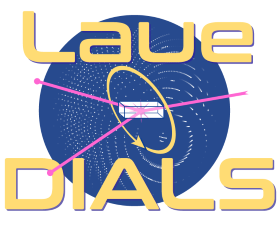"""
This file contains useful functions for diffraction geometry calculations
"""
import numpy as np
import reciprocalspaceship as rs
[docs]
def get_UB_matrices(A):
"""
Convert the reciprocal space indexing matrix, A into the product of
an orthogonal matrix U and a lower triangular matrix B.
Parameters:
A (np.array): A 3x3 indexing matrix such that the scattering vector `S1-S0=Q=A@h`.
Returns:
U (np.array): An orthogonal 3x3 matrix with the crystal U matrix.
B (np.array): A 3x3 lower triangular matrix for the crystal B matrix.
"""
from scipy.linalg import rq
# R is a "right" or upper triangular matrix
# Q is an orthogonal (rotation) matrix
# A = Q.T@R.T
R, Q = rq(A.T)
return Q.T, R.T
[docs]
def normalize(A):
"""
Normalize the last dimension of an array by dividing by its L2 norm.
Parameters:
A (np.array): A non-normal matrix.
Returns:
A (np.array): A normalized matrix.
"""
normalized_A = A / np.linalg.norm(A, axis=-1)[..., None]
# In case of magnitude-0 rows:
normalized_A[np.isnan(normalized_A)] = 0
return normalized_A
[docs]
def hkl2ray(hkl, wavelength=None):
"""
Convert a miller index to the shortest member of its central ray.
Optionally, adjust its wavelength accordingly.
Parameters:
hkl (np.array): `n x 3` array of miller indices. The dtype must be interpretable as an integer.
wavelength (Optional[np.array]): Length `n` array of wavelengths corresponding to each miller index.
Returns:
reduced_hkl (np.array): The miller index of the shortest vector on the same central ray as the original hkl.
reduced_wavelength (Optional[np.array]): The wavelengths corresponding to reduced_hkl.
"""
gcd = np.gcd.reduce(hkl.astype(int), axis=-1)
if wavelength is not None:
return hkl / gcd[..., None], wavelength * gcd
else:
return hkl / gcd[..., None]
[docs]
def is_ray_equivalent(hkl1, hkl2):
"""
Test for equivalency between two miller indices in a Laue experiment.
Returns a boolean array for each of the `n` hkls in `hkl{1,2}`.
Parameters:
hkl1 (np.array): `n x 3` array of miller indices. The dtype must be interpretable as an integer.
hkl2 (np.array): `n x 3` array of miller indices. The dtype must be interpretable as an integer.
Returns:
equal_hkl (np.array): Boolean array for hkl equivalency by index from original arrays.
"""
return np.all(np.isclose(hkl2ray(hkl1), hkl2ray(hkl2)), axis=1)
[docs]
def align_hkls(reference, target, spacegroup, anomalous=True):
"""
Use the point group operators in `spacegroup` to align target hkls to reference.
Parameters:
reference (np.array): n x 3 array of miller indices.
target (np.array): n x 3 array of miller indices.
spacegroup (gemmi.Spacegroup): The space group of reference/target.
anomalous (bool, optional): If true, test Friedel symmetries too.
Returns:
aligned (np.array): n x 3 array of miller indices equivalent to target.
"""
aligned = target
cc = -1.0
for op in spacegroup.operations():
aligned_ = rs.utils.apply_to_hkl(target, op)
cc_mat = np.corrcoef(aligned_.T, reference.T)
cc_ = np.trace(cc_mat[:3, 3:])
if cc_ > cc:
aligned = aligned_
cc = cc_
if anomalous:
for op in spacegroup.operations():
aligned_ = -rs.utils.apply_to_hkl(target, op)
cc_mat = np.corrcoef(aligned_.T, reference.T)
cc_ = np.trace(cc_mat[:3, 3:])
if cc_ > cc:
aligned = aligned_
cc = cc_
return aligned
[docs]
def orthogonalization(a, b, c, alpha, beta, gamma):
"""
Compute the orthogonalization matrix from cell params.
Parameters:
a, b, c (float): Floats representing the magnitudes of the three unit cell axes.
alpha, beta, gamma (float): Floats representing the three unit cell angles.
Returns:
orthogonalization_matrix (np.array): 3 x 3 orthogonalization matrix for unit cell.
"""
alpha, beta, gamma = (
np.pi * alpha / 180.0,
np.pi * beta / 180.0,
np.pi * gamma / 180.0,
)
cosa = np.cos(alpha)
cosb = np.cos(beta)
cosg = np.cos(gamma)
sing = np.sin(gamma)
V = (
a
* b
* c
* np.sqrt(
1.0 - cosa * cosa - cosb * cosb - cosg * cosg + 2 * cosa * cosb * cosg
)
)
return np.array(
[
[a, b * cosg, c * cosb],
[0.0, b * sing, c * (cosa - cosb * cosg) / sing],
[0.0, 0.0, V / a / b / sing],
]
)
[docs]
def mat_to_rot_xyz(R, deg=True):
"""
Decompose a rotation matrix into euler angles.
Parameters:
R (np.array): 3 x 3 rotation matrix.
deg (Optional[bool]): If True, angles are returned in degrees.
Returns:
rot_x (float): Euler angle around x-axis to generate rotation matrix.
rot_y (float): Euler angle around y-axis to generate rotation matrix.
rot_z (float): Euler angle around z-axis to generate rotation matrix.
"""
if R[2, 0] < 1:
if R[2, 0] > -1:
rot_y = np.arcsin(-R[2, 0])
rot_z = np.arctan2(R[1, 0], R[0, 0])
rot_x = np.arctan2(R[2, 1], R[2, 2])
else:
rot_y = np.pi / 2.0
rot_z = -np.arctan2(-R[1, 2], R[1, 1])
rot_x = 0.0
else:
rot_y = np.pi / 2.0
rot_z = np.arctan2(-R[1, 2], R[1, 1])
rot_x = 0.0
if deg:
rot_x = np.rad2deg(rot_x)
rot_y = np.rad2deg(rot_y)
rot_z = np.rad2deg(rot_z)
return rot_x, rot_y, rot_z
[docs]
def rot_xyz_to_mat(rot_x, rot_y, rot_z, deg=True):
"""
Convert euler angles into a rotation matrix.
Parameters:
rot_x (float): Euler angle around x-axis to generate rotation matrix.
rot_y (float): Euler angle around y-axis to generate rotation matrix.
rot_z (float): Euler angle around z-axis to generate rotation matrix.
deg (Optional[bool]): If True, input angles are assumed to be in degrees.
Returns:
R (np.array): 3 x 3 rotation matrix.
"""
if deg:
rot_x = np.deg2rad(rot_x)
rot_y = np.deg2rad(rot_y)
rot_z = np.deg2rad(rot_z)
cx, sx = np.cos(rot_x), np.sin(rot_x)
cy, sy = np.cos(rot_y), np.sin(rot_y)
cz, sz = np.cos(rot_z), np.sin(rot_z)
return np.array(
[
[cy * cz, cz * sx * sy - cx * sz, cx * cz * sy + sx * sz],
[cy * sz, cx * cz + sx * sy * sz, -cz * sx + cx * sy * sz],
[-sy, cy * sx, cx * cy],
]
)
